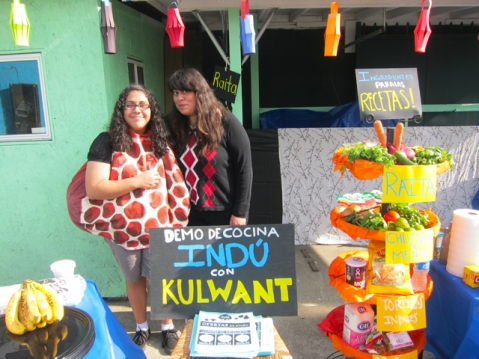East LA’s Fresh Food Advocates
Some of us are lucky enough to live in a neighborhood where we can find fresh fruits and vegetables and other healthy food options within a short car ride or walking distance from our homes. For those who live in a “food desert” (and especially those who do not have a car or access to reliable public transportation) the options are usually limited to fast food restaurants, street food, 99 cent stores, liquor stores and inadequate local corner markets; and options can have a huge impact on a neighborhood’s health.
Local East Los Angeles resident, Clara Mejia understands what it’s like to live in a food desert. “In East L.A. it’s cheaper and easier to buy four fast food hamburgers than to cook a healthy meal at home,” she said. “There just aren’t many options for healthy food here.” Clara describes a food desert as “a place that has a lack of access to healthy produce and mainstream grocery stores”. East Los Angeles residents have suffered from the lack of accessible food options in their community by having some of the high rates of obesity, heart disease, hypertension and stroke in Los Angeles County.
Clara and her classmates at East L.A. Renaissance Academy (ELARA), School of Urban Planning and Design are learning how to change this paradigm by thinking critically about food justice and how to an active agent of change their community. In 2010, ELARA partnered with Public Matters (LINK) and the UCLA-USC Center for Population Health and Health Disparities to increase access and consumption of healthy foods among Latino’s in East L.A by transforming four corner stores into venues with healthier food options.The program called “Proyecto MercadoFresco del Este de Los Angeles” is part of a five-year long initiative tilted “Family and Neighborhood Interventions to Reduce Heart Disease Risk in East L.A.”
ELARA students have been working with Public Matters to learn about the negative impact of food deserts on public health and how to use social marketing, media (check out their amazing video below!) and community engagement to become advocates for healthy food options. Last Summer, Clara and her classmates helped to transform Yash la Casa Corner Market with facade treatments, refrigeration upgrades, a community garden and multi-cultural cooking classes demonstrating affordable meals options. Clara says: “After we started the project, Kulwant, the store owner, asked if we could build a garden. A total of 26 students broke the concrete in the back of the store, brought in soil and plants, and painted the walls with stencils and silhouettes of fruits and vegetables”. The transformation of the market really became a community event and helped bring those involved closer together around these issues.
When she began her classes with Public Matters, Clara she had no idea how transformative the classes would be. “We even planted our own garden at home, including apples, peaches, tomatoes, beets, carrots, lettuce, squash, broccoli, and zucchini.” As Clara points out, the root of the issue is about having access: “People in East L.A. would eat healthier if they had options for buying healthy food.”
Have You Noticed How Often You Eat Fast Food? from Public Matters on Vimeo.

